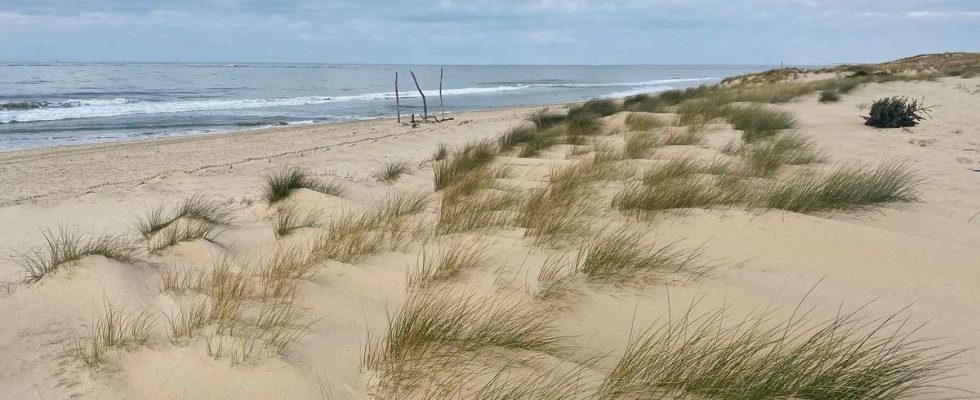Delivered in the middle of summer, this study aims to recall the challenges of preserving ocean dunes, and to raise awareness among all those who frequent the beaches of the Atlantic coast, particularly these days with the high temperatures. The “dune cord” on the coast of New Aquitaine has shrunk by a third in twenty-five years, between 1997 and 2021, reveals the Sentinelles du climat program. Coordinated by the Cistude Nature association, it focuses on the effects of climate change on biodiversity in New Aquitaine.
More than ever, it is therefore essential to respect the marked trails to access the beach, and not to trample the dune where sensitive species nest, recalls the environmental association.
It is in particular the “grey dune”, this space which constitutes a buffer zone between the land and the “white dune”, on the ocean side, which has been the most weakened during this quarter of a century. However, many species are specific to this gray dune, and some are even endemic there: they are only found in New Aquitaine.
“A complete loss of species has been observed in some areas”
“This loss of a third of the surface of the dune is very heterogeneous depending on the site, which generates an isolation of certain species, explains Michaël Guillon, coordinator of the Sentinelles du climat program. It is very damaging for the fauna and flora because it disconnects the populations from each other. “We can see that more and more white dune is colonizing the gray dune, and conversely species of gray dunes are found in the white dune, continues Kevin Romeyer, botanist at the South Atlantic National Botanical Conservatory. This shows that the dune is gradually receding towards the forest. »
Among the plant species endemic to the dune, “we find thyme-leaved toadflax, Porto silenus, or French carnation” lists Kevin Romeyer. “There is a whole procession of species dependent on the dune rim, even on a small part of the dune, and in certain sectors a complete loss of these species has been observed. »
Too hot, even for the Ocellated Lizard
On the fauna side, Pond Terrapin has closely followed the evolution of the Ocellated Lizard, a Mediterranean species but present in New Aquitaine, particularly on the Atlantic coast. “This is what motivated us to follow this species, explains Michaël Guillon, because at first glance one might think that the effects of climate change could be beneficial to it, but we know such heat waves, that the temperature on the ground can reach 50°C, which is even too much for this Mediterranean lizard, forced to stay hidden more, which reduces its time range to feed and reproduce. »
The Ocellated Lizard is also “very dependent on the environment in which it lives”, continues Michaël Guillon, “and the effects of the retreat of the dune on the habitats have indirect consequences on this species as well. Conclusion: “We also observe a phenomenon of fragmentation for this species, with fairly dense nuclei in certain places, and very weak or even non-existent in others. »
“The majority pressure comes from wind erosion”
Among the causes put forward by scientists to explain this “significant” retreat of the dune, “we note a rise in sea level due to climate change, which remains measured for the moment but which is no less real” , assures Michaël Guillon. He also notes “an increase in the intensity of winter storms, which eat away at the first habitats of the dune on the coast and cause silting up of other habitats”.
“The main pressure comes from wind erosion, which is continuous throughout the year and accentuated by storms, adds Kevin Romeyer. This is what generates the burial of the gray dune by the white dune, the gray dune not being able to shift towards the east, since the forest constitutes a barrier. »
“Giving back space to the dune”
To the pressure from the west coming from the ocean, from the east coming from the pine forest, is added “a pressure from above”, adds Michaël Guillon, “with a phenomenon of eutrophication, the modification atmosphere linked to climate change causing nitrogen deposits in areas where there is no agricultural activity”. Finally, “urbanization also brings more competitive, even invasive species” such as the Cape Groundsel, “a species typical of the edges of the motorway that we find today in the Landes, and which competes with dune species”, points out Kevin Romeyer.
What can be done to stop this phenomenon of erosion? “The first thing is to reduce greenhouse gas emissions, the primary cause of global warming,” recalls the botanist. “At the same time, we must carry out a major action on the dune, by giving it back space, in particular by limiting the invasion of the pine tree”, adds Michaël Guillon. Pond Terrapin thus intends “to set up a project with all the partners linked to these spaces such as the ONF”.

